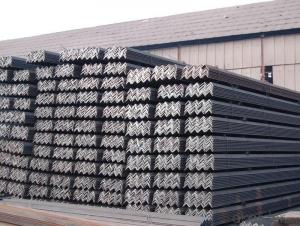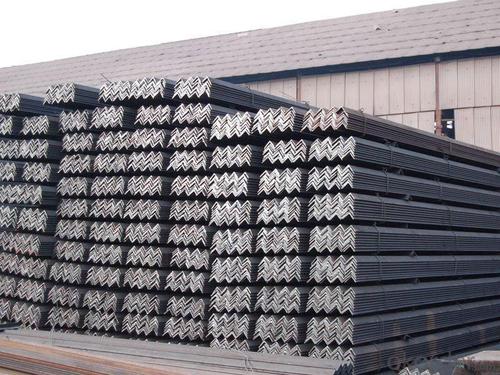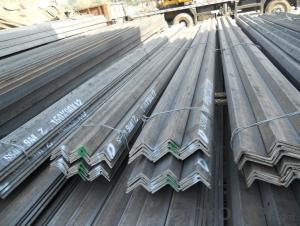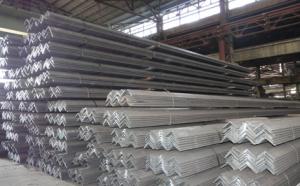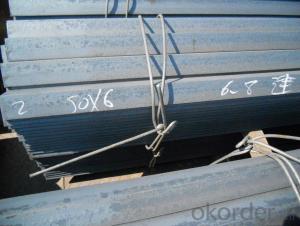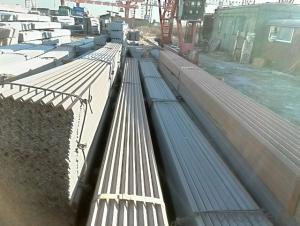Hot Rolled Carbon Angle Steel Iron
- Loading Port:
- China Main Port
- Payment Terms:
- TT or LC
- Min Order Qty:
- 100 m.t.
- Supply Capability:
- 10000MT m.t./month
OKorder Service Pledge
OKorder Financial Service
You Might Also Like
Product Description:
OKorder is offering Hot Rolled Carbon Angle Steel Iron at great prices with worldwide shipping. Our supplier is a world-class manufacturer of steel, with our products utilized the world over. OKorder annually supplies products to African, South American and Asian markets. We provide quotations within 24 hours of receiving an inquiry and guarantee competitive prices.
Product Applications:
Hot Rolled Carbon Angle Steel Iron are ideal for structural applications and are widely used in the construction of buildings and bridges, and the manufacturing, petrochemical, and transportation industries.
Product Advantages:
OKorder's Hot Rolled Carbon Angle Steel Iron are durable, strong, and wide variety of sizes.
Main Product Features:
· Premium quality
· Prompt delivery & seaworthy packing (30 days after receiving deposit)
· Can be recycled and reused
· Mill test certification
· Professional Service
· Competitive pricing
Product Specifications:
Manufacture: Hot rolled
Grade: Q195 – 235
Certificates: ISO, SGS, BV, CIQ
Length: 6M-12m, as per customer request
Packaging: Export packing, nude packing, bundled
EQUAL ANGLES SIZES |
| ||
a(mm) | a1(mm) | thickness(mm) | length |
25 | 25 | 2.5---3.0 | 6M/12M |
30 | 30 | 2.5---4.0 | 6M/12M |
38 | 38 | 2.5 | 6M/12M |
38 | 38 | 3.0---5.0 | 6M/12M |
40 | 40 | 3.0---6.0 | 6M/12M |
50 | 50 | 3 | 6M/12M |
50 | 50 | 3.7---6.0 | 6M/9M/12M |
60 | 60 | 5.0---6.0 | 6M/9M/12M |
63 | 63 | 6.0---8.0 | 6M/9M/12M |
65 | 65 | 5.0---8.0 | 6M/9M/12M |
70 | 70 | 6.0---7.0 | 6M/9M/12M |
75 | 75 | 5.0---10.0 | 6M/9M/12M |
80 | 80 | 6.0---10.0 | 6M/9M/12M |
90 | 90 | 6.0---10.0 | 6M/9M/12M |
100 | 100 | 6.0---12.0 | 6M/9M/12M |
120 | 120 | 8.0-12.0 | 6M/9M/12M |
125 | 125 | 8.0---12.0 | 6M/9M/12M |
130 | 130 | 9.0-12.0 | 6M/9M/12M |
140 | 140 | 10.0-16.0 | 6M/9M/12M |
150 | 150 | 10---15 | 6M/9M/12M |
160 | 160 | 10---16 | 6M/9M/12M |
180 | 180 | 12---18 | 6M/9M/12M |
200 | 200 | 14---20 | 6M/9M/12M |
FAQ:
Q1: Why buy Materials & Equipment from OKorder.com?
A1: All products offered byOKorder.com are carefully selected from China's most reliable manufacturing enterprises. Through its ISO certifications, OKorder.com adheres to the highest standards and a commitment to supply chain safety and customer satisfaction.
Q2: How do we guarantee the quality of our products?
A2: We have established an advanced quality management system which conducts strict quality tests at every step, from raw materials to the final product. At the same time, we provide extensive follow-up service assurances as required.
Q3: How soon can we receive the product after purchase?
A3: Within three days of placing an order, we will arrange production. The normal sizes with the normal grade can be produced within one month. The specific shipping date is dependent upon international and government factors, the delivery to international main port about 45-60days.
Images:
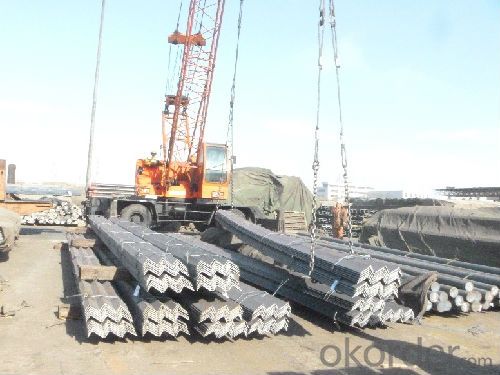
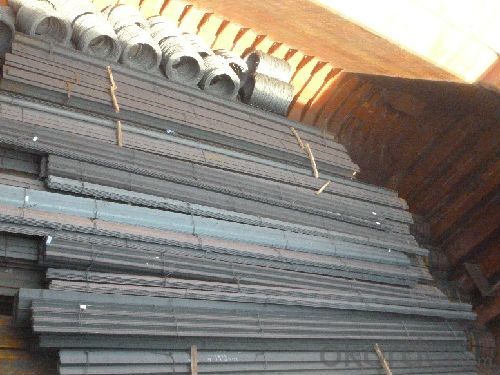
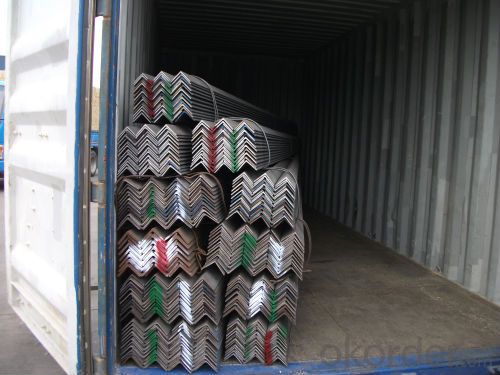
- Q: How are steel angles protected against impact damage?
- Steel angles can be protected against impact damage through various means, such as installing protective barriers or guards, using impact-resistant coatings, or incorporating shock-absorbing materials.
- Q: Can steel angles be used in the construction of warehouses?
- Yes, steel angles can be used in the construction of warehouses. Steel angles are commonly used as structural components in buildings and warehouses due to their strength and durability. They provide stability and support to the overall structure, making them suitable for use in various construction applications. Steel angles can be used as framing members, columns, beams, and supports in warehouse construction, helping to create a robust and reliable structure. Additionally, steel angles are versatile and can be easily customized and fabricated to meet specific design requirements, making them a popular choice in warehouse construction projects.
- Q: How do steel angles contribute to the overall safety of a building?
- Steel angles contribute to the overall safety of a building by providing structural support and reinforcement. They are commonly used in construction to connect and strengthen various structural components, such as beams, columns, and trusses. Steel angles help distribute loads and resist forces, such as wind, earthquakes, and heavy loads, thereby enhancing the building's stability and resistance to collapse. Additionally, they can prevent lateral movement and deformation, ensuring the structural integrity of the building.
- Q: How do steel angles perform under lateral or wind loading conditions?
- Due to their strength and versatility, steel angles find widespread use in construction and engineering. They excel in handling lateral or wind loading conditions, demonstrating exceptional performance. When subjected to lateral forces acting horizontally and perpendicular to their axis, steel angles exhibit remarkable rigidity and resistance to bending. Consequently, they can withstand substantial lateral loads, making them perfect for applications such as bracing systems, support structures, and framing components that need to resist wind, seismic, or other lateral forces. Similarly, steel angles prove their excellence in wind loading conditions. As wind exerts a strong lateral force on structures, steel angles effectively counteract these forces. By securely fastening steel angles to the structure, stability is ensured, preventing wind-induced vibrations or even collapse. To enhance the performance of steel angles under lateral or wind loading conditions, proper design and installation are crucial. Engineers take into account factors like angle size and thickness, steel type and quality, as well as connection details. By carefully analyzing specific loading conditions and selecting the appropriate steel angles, engineers guarantee that structures remain stable and safe, even under extreme lateral or wind loads. In conclusion, steel angles are highly reliable and durable in handling lateral or wind loading conditions. Their robustness, coupled with their cost-effectiveness and ease of installation, makes them a favored choice in numerous construction and engineering projects.
- Q: What is the typical thickness of a steel angle?
- The specific application and the desired strength are factors that can cause the typical thickness of a steel angle to vary. Generally, steel angles are offered in various thickness options, ranging from 1/8 inch (3.18 mm) to 3/4 inch (19.05 mm) or greater. Determining the appropriate thickness involves considering aspects like load-bearing necessities, structural design, and the desired durability level.
- Q: Can steel angles be used in conveyor systems?
- Conveyor systems can indeed utilize steel angles. These angles are frequently employed in conveyor systems to provide stability and structural support. They can be employed to establish the framework for the conveyor system, encompassing the conveyor bed, side frames, and supports. Steel angles are renowned for their durability and strength, making them an optimal choice for handling hefty loads and enduring the continual movement and impact encountered by conveyor systems. Furthermore, steel angles can be easily joined through welding or bolting, enabling flexibility in designing and customizing conveyor systems to meet specific requirements. In summary, steel angles are a sought-after option in conveyor system construction due to their dependability, adaptability, and cost-effectiveness.
- Q: Are steel angles resistant to UV radiation?
- Steel angles are not inherently resistant to UV radiation. However, the level of resistance can vary depending on the type of steel used and the protective coating applied to the surface. Unprotected steel angles, such as hot-rolled or cold-formed steel, are susceptible to degradation and corrosion when exposed to UV radiation over time. The ultraviolet rays can cause the steel to oxidize, leading to rust formation and structural weakness. To mitigate the effects of UV radiation, steel angles can be coated with protective finishes such as galvanized zinc, paint, or powder coating. These coatings serve as a barrier between the steel and the environment, providing resistance to UV radiation and preventing oxidation and corrosion. It is important to note that even with protective coatings, prolonged exposure to intense UV radiation can still cause some deterioration over time. Therefore, regular inspection and maintenance are necessary to ensure the longevity and structural integrity of steel angles in outdoor or UV-exposed applications.
- Q: What are the considerations for selecting the appropriate steel angle length?
- When selecting the appropriate steel angle length, there are several considerations to keep in mind. Firstly, the intended application and usage of the steel angle should be considered. This includes factors such as the load-bearing capacity required, the structural design of the project, and any specific engineering or architectural requirements. Secondly, the dimensions and measurements of the project should be taken into account. This involves considering the overall size and shape of the structure, as well as the specific location and orientation where the steel angle will be installed. Additionally, the availability and cost of different steel angle lengths should be considered. It is important to assess the cost-effectiveness and availability of different lengths to ensure that the chosen length aligns with the project budget and timeframe. Lastly, it is crucial to consult industry standards and regulations when selecting the appropriate steel angle length. Adhering to specific guidelines and codes ensures the safety and compliance of the structure, and helps to avoid any potential issues or risks in the future. By considering these factors, one can make an informed decision when selecting the appropriate steel angle length for their specific project.
- Q: How do you determine the shear capacity of a steel angle?
- In order to establish the shear capacity of a steel angle, various factors must be taken into account. The shear capacity signifies the maximum load that the angle can endure without experiencing shear failure. The initial step in determining the shear capacity involves identifying the characteristics of the steel angle, such as the grade of the material and its dimensions. The strength properties of the steel, which are crucial for calculating the shear capacity, are determined by its grade. The calculations are also significantly influenced by the dimensions of the angle, including its length, width, and thickness. Subsequently, it becomes necessary to ascertain the critical shear area of the angle. This area represents the section of the angle that will encounter the highest shear stress during loading. By considering the location of the applied load and the geometry of the angle, the critical shear area can be calculated. Once the critical shear area is determined, the subsequent step is to compute the shear stress exerted on this area. The shear stress is calculated by dividing the applied load by the area. It is crucial to ensure that the shear stress does not surpass the allowable shear stress for the specific grade of steel being utilized. The allowable shear stress is typically provided by design codes or standards. Finally, the shear capacity of the steel angle can be calculated by multiplying the shear stress by the critical shear area. This calculation yields the maximum load that the angle can withstand without experiencing shear failure. It is important to bear in mind that the shear capacity of a steel angle can be influenced by additional factors such as the presence of holes or welds, which can weaken the structure. In such cases, further calculations or considerations may be necessary. Overall, the process of determining the shear capacity of a steel angle encompasses considering the properties of the steel, calculating the critical shear area, determining the shear stress, and ensuring that it does not exceed the allowable shear stress for the material grade.
- Q: What is the difference between galvanized steel angle and ordinary angle iron?
- Ordinary steel angle and cold galvanized steel angle per ton difference of about 500 yuan;
Send your message to us
Hot Rolled Carbon Angle Steel Iron
- Loading Port:
- China Main Port
- Payment Terms:
- TT or LC
- Min Order Qty:
- 100 m.t.
- Supply Capability:
- 10000MT m.t./month
OKorder Service Pledge
OKorder Financial Service
Similar products
Hot products
Hot Searches
Related keywords
